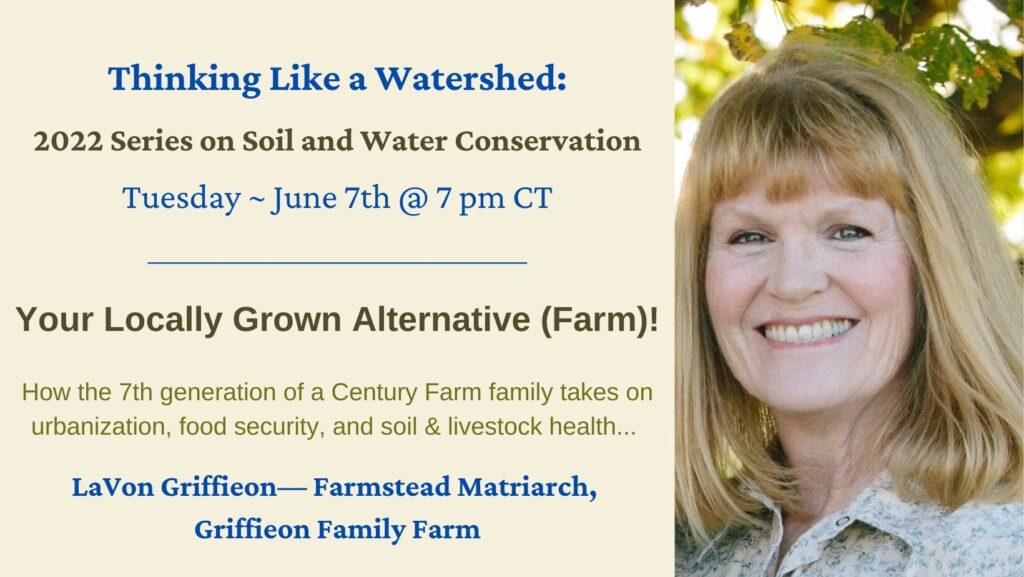
The Middle Fork of the Whitewater River behind the Visitors Center at Whitewater State Park has been a monitoring site for us since we began this endeavor three years ago. Our fall macroinvertebrate score has been a consistent 16 or 18, and this year, at 16, proved no different even though the water level reflected the droughty summer. It’s a good sign of health, and provides a growing record of baseline data in the event of a fish kill, manure spill, or other degradation. Volunteers Deb and Jeff Cadwell and Amy Cordry trained together as members of our first cohort and are shown here on Oct. 27, 2022, still having fun! Photo by Caroline van Schaik
But first!
Top of page for deadlines, with details below. Read on for how to act on your priorities:
- Fall water sampling at eight Driftless sites in southeast Minnesota ongoing now. No experience required; enthusiasm mandatory! A few sites left…
Stream side sampling, SOS-style
Our Driftless stream teams are out and about for fall sampling and despite the droughty summer, are finding good chemistry and life in Driftless waters. We have several sites yet on the calendar, including Mill Creek in Chatfield, MN on Nov. 10. Please contact Caroline van Schaik if you would like to get your hands wet, literally, in the world of water chemistry and biology, data collection, and a lovely way to be outdoors and contributing to an ongoing understanding of our public waters. Plus, this is a good way to prepare for an in-person training on Save Our Streams protocol (SOS). Read on for details.

This is what the home page for a given stream site looks like on The Clean Water Hub– this one being the Zumbro River in Oxbow Park near Byron, MN. where volunteers sampled Oct. 30, 2022. To see more, here’s the exact site!

This screenshot gives you an idea of some of the data to be found for hundreds of stream sites nationwide. SOS volunteers sampled the middle fork of the Zumbro River as it winds through Oxbow Park near Byron, MN. in late October. Despite the droughty summer, stream life was vibrant – Driftless Region scores typically run in the 9-15 range; the day yielded a whopping 21 and some delightful critters in the form of water snipes, dragonflies, a fat crane fly, tens (and tens!) of net spinning caddisflies, and many (many!) mayflies, among others. It was a banner afternoon!
SOS training in-person
We will be hosting an in-person Save Our Streams (SOS) training between now and next spring and are collecting names of interested people for this limited-space event. Please contact Caroline van Schaik if this interests you. Our stream side program will take place on public waters in southeast Minnesota with certified trainer Dr. Jenny Biederman.
As we mentioned last month, sampling with us this fall is a good way to get a sense of the volunteer program. The national website is worth a browse as well. The SOS program, begun 51 years ago, is a national effort by the Izaak Walton League to engage all sorts of people in collecting data across the US according to standard protocols. Data are uploaded to a searchable hub and are used at the federal level to inform water policy and practice. In-person training had been suspended due to Covid; a grant from the IWLA Endowment Board allows us to reconsider this option.

Save Our Streams (SOS) training in southeast Minnesota will take place this fall or early next spring. Eased Covid restrictions allow us to resume the stream side portion of becoming SOS certified though some components remain online at https://www.iwla.org/water/stream-monitoring. Certification is not required to join a stream team but it makes for a richer experience and it does permit one to enter team data on the national Clean Water Hub (www.cleanwaterhub.org). By the way, anyone can browse the Hub to see what other streams look like all over the United States. Photo by Caroline van Schaik
Match…making
The funded project to discern what crop and livestock producers need to put their farming together for better soil, finances, and more has moved into survey mode. The survey will be ready soon after months of design by a 6-state committee (UMRI is an active member) and especially the core staff at Green Lands Blue Waters Midwest Perennial Forage Working Group (https://greenlandsbluewaters.org/match-made-in-heaven-livestock-crops). If you are a farmer and want to take this survey, to be counted and heard, and to help do better by our land and your pocketbook, please, contact Caroline van Schaik for how to do so anonymously.

The “Match Made in Heaven” project is working to understand how to forge more marriages between crop and livestock producers in a way that, at the end of every day, finds more soil covered more months of the year. This simple bottom line positively affects farm financials, every aspect of the environment including drinking water and human health, climate mitigation, and communities. The 6-state committee headed by Green Lands Blue Waters Midwest Perennial Forage Working Group designed this infographic to explain what we envision. It is available for reprint and sharing in any form, for free

The goals of the “Match Made in Heaven” project are straightforward if ambitious. A survey is about to released to understand barriers to these goals; we aim to get it into 10,000 farmer hands. If you as a farmer wants to take it or your organization wants to help distribute it, please contact Caroline van Schaik. There is some financial help for print and postage.
UMRI’s “Thinking Like a Watershed” series has gone fishin’!
Not wishing to compete with long summer days – and who would want to! – we hosted our final 2022 “Thinking Like a Watershed” episode on June 7. Go outside! We will see you in January for stories to inspire a winter’s night, as told by ourselves and good partners on this road to a better landscape. The linked recording of the June 7 presentation – by the head of a 7th generation farm creatively grappling with urban sprawl – is below, as are links to all past programs. Take a listen, take some hope, and let us know if you would like us to consider a certain someone or topic in programs to come. And if you are new to the series, we use these words to describe what shapes it: This monthly series is a project of the Upper Mississippi River Initiative (UMRI) of the Izaak Walton League of America, with co-hosts Chris Henning of the Panora Conservation Chapter and Des Moines Chapter Communication Director, Bud Hartley. We feature guests for 30-40 minute presentations that shed daylight on good works done in the name of the Mississippi and its uplands. In this way we uplift our shared goals for a cleaner river, a cared for environment, and kinder communities. Recorded programs are available shortly after they air live.
Links to recent “Thinking” presentations
— “Your Locally Grown Alternative (Farm)”: Thinking Like a Watershed ~ LaVon Griffieon- Tuesday June 7, 2022 How the 7th generation of a Century Farm family takes on urbanization, food security, and soil and livestock health… with farmstead matriarch, LaVon Griffieon
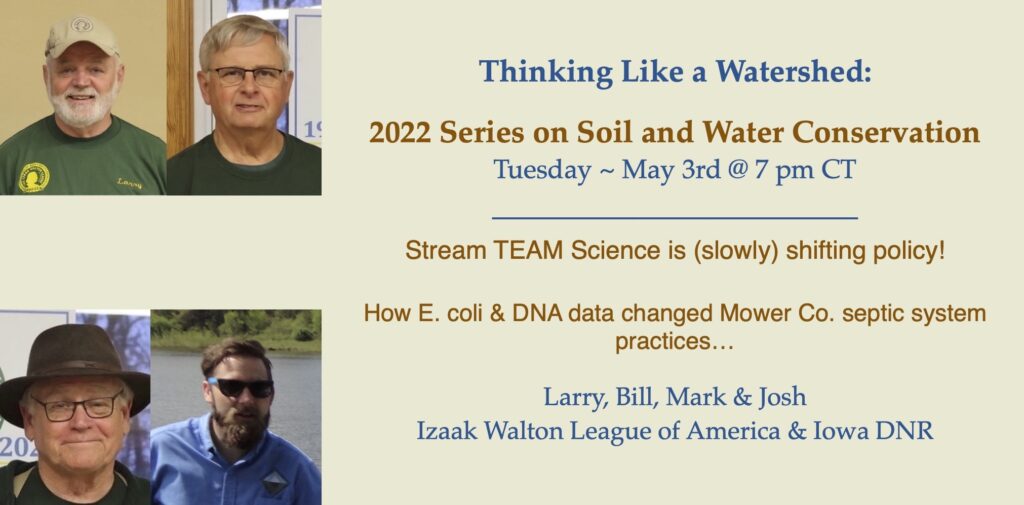
— “Stream TEAM Science is (slowly) shifting policy!” Thinking Like a Watershed ~ Tuesday, May 3, 2022
How E. coli & DNA data changed Mower Co. septic system practices…
A discussion with leaders Larry Dolphin, Bill Buckley, Mark Owens, lifelong members of the Izaak Walton League (IWLA), and Josh Balk, Iowa Department of Natural Resources (DNR)
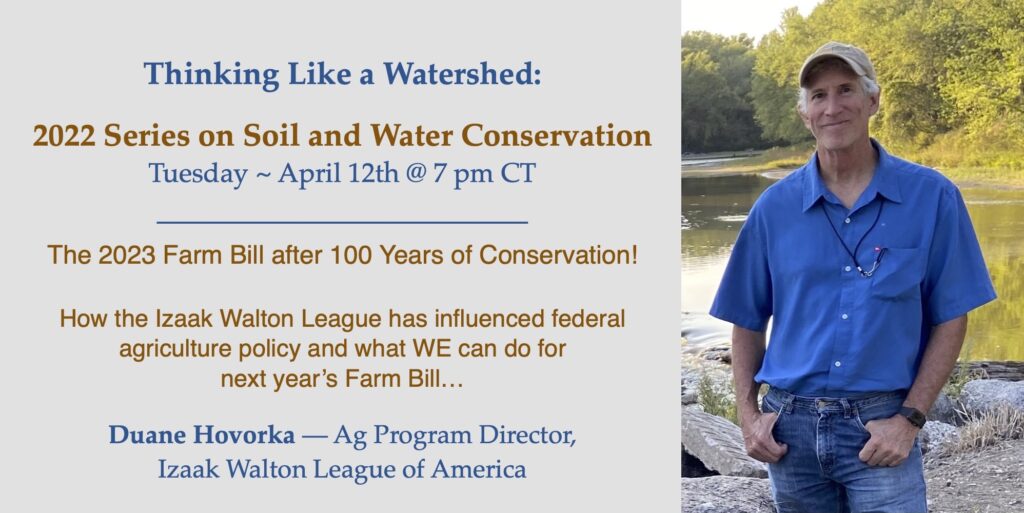
—“The 2023 Farm Bill after 100 Years of Conservation!” Thinking Like a Watershed ~ Duane Hovorka- April 12th, 2022
How the Izaak Walton League has influenced federal agriculture policy and what WE can do for next year’s Farm Bill…with Duane Hovorka, Agriculture Program Director, Izaak Walton League of America
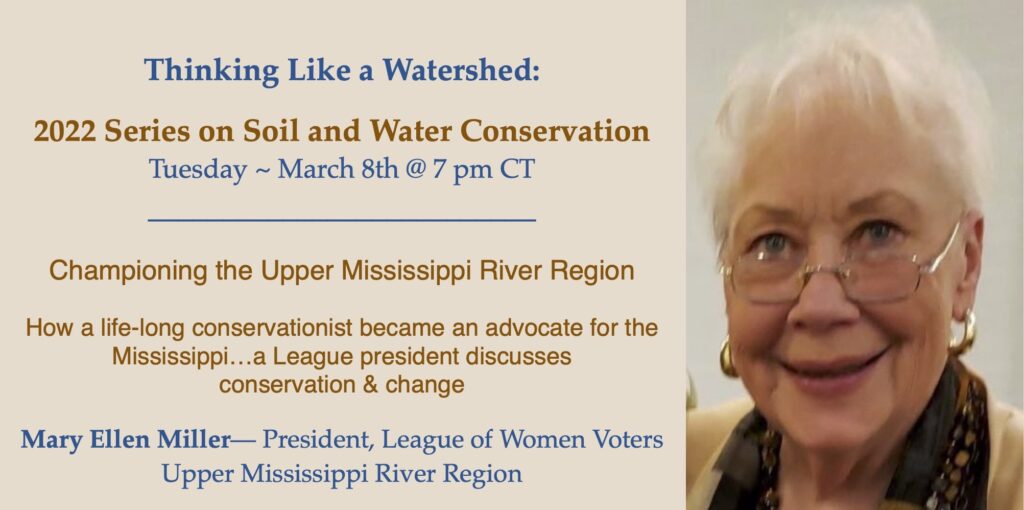
— “Championing the Upper Mississippi River Region” Thinking Like a Watershed ~ Mary Ellen Miller— March 8th, 2022
How a life-long conservationist became an advocate for the Mississippi…a League president discusses conservation & change with Mary Ellen Miller, President, League of Women Voters Upper Mississippi River Region
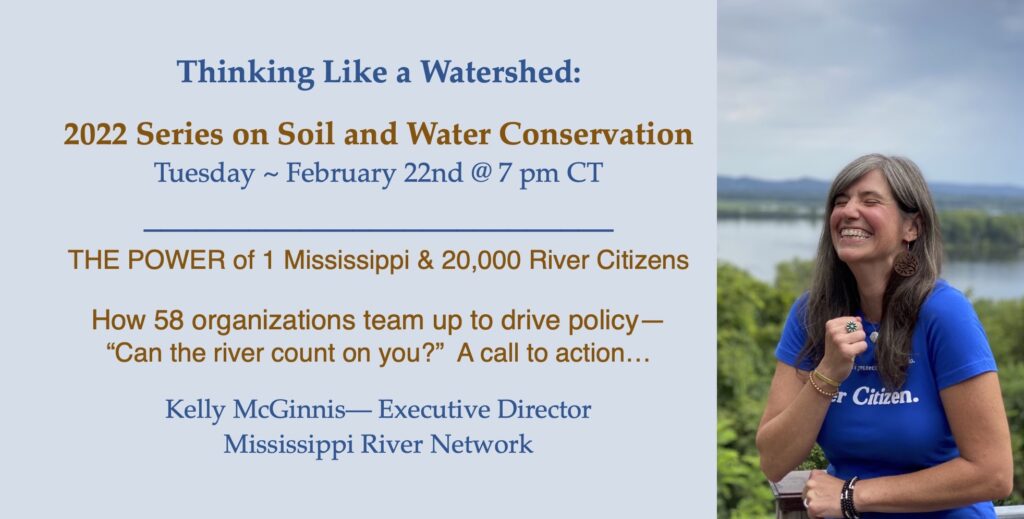
—“The POWER of 1 Mississippi & 20,000 River Citizens” Thinking Like a Watershed ~ Kelly McGinnis— February 22nd, 2022 How 58 organizations team up to drive policy—“Can the river count on you?” A call to action…
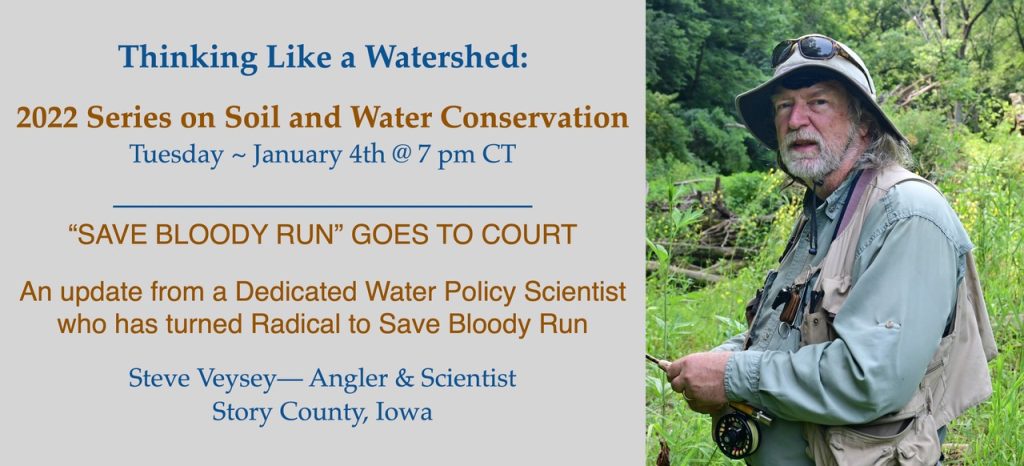
Photo by: David Thoreson
— “Save Bloody Run Goes to Court” Thinking Like a Watershed ~ Steve Veysey— January 4th, 2022 An update from a Dedicated Water Policy Scientist who has turned Radical to Save Bloody Run.
—“Heartland Heroines” Thinking Like a Watershed ~ Robin Moore & Denise O’Brien— June 1, 2021 How two savvy conservationists empower working farm landowners to put their inner land ethic to work.
—“Planting Seeds to Grow Vibrant Communities” Thinking Like a Watershed ~ Chris Deal & Art Cullen— May 4, 2021 How Jefferson, Iowa’s Chris Deal is working with California Rep. Ro Khanna and others to grow vibrant rural communities in the Heartland with perspectives from Pulitzer Prize—winning journalist and editor of The Storm Lake Times, Art Cullen.
—“Watershed Bridges— Green to Blue” Thinking Like a Watershed ~ Vicki Nichols Goldstein & Seth Watkins— April 6, 2021 How improving soil health and water quality in Iowa and other inland states benefit watersheds that provide critical services from land to sea.
—“Local Heroes in Howard County” Thinking Like a Watershed ~ Neil Shaffer & Hunter Slifka— March 2, 2021 How they have incorporated several thousand acres of land under conservation programs–the largest percentage in Iowa.
—“The Accidental Conservationist” Thinking Like a Watershed ~ Wayne Fredericks— February 2, 2021 How an Iowa Farmer is Improving Natural Capital while Increasing Profits with Conservationist and Farmer, Wayne Fredericks from Mitchell County, Iowa.

